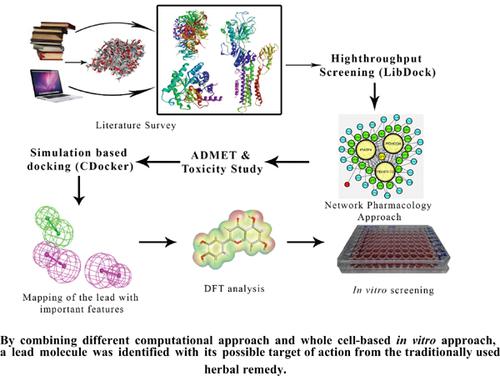Current Computer-Aided Drug Design ( IF 1.5 ) Pub Date : 2021-01-31 , DOI: 10.2174/1573409916666191226103000 Neelutpal Gogoi 1 , Dipak Chetia 1 , Bhaskarjyoti Gogoi 2 , Aparoop Das 1

|
Background: Development of resistance by the malaria parasite Plasmodium falciparum has created challenges in the eradication of this deadly infectious disease. Hence newer strategies are adopted to combat this disease and simultaneously, new lead/hit identification is going on worldwide to develop new chemotherapeutic agents against malaria.
Objective: In this study, 44 flavonoids found mainly in the fruit juice of Citrus species having traditional use in malaria-associated fever were selected for in silico multiple-target directed screening against three vital targets of the parasite namely dihydroorotate dehydrogenase (PfDHODH), dihydrofolate reductase thymidine synthase (PfDHFR-TS) and plasma membrane P-type cation translocating ATPase (PfATP4) to find out new lead molecule(s).
Methods: The in silico screening was carried out using different protocols of the Biovia Discovery Studio 2018 software and Network analyzer plugin of Cytoscape 3.6.0 followed by in vitro screening of the best lead.
Results: After screening, CF8 or luteolin was found to have good binding affinity against PfDHODH and PfATP4 with –CDocker energy 42.2719 and 33.1447 with respect to their cocrystal ligands. These findings were also supported by structure-based pharmacophore, DFT (Density Functional Theory) study and finally by in vitro screening of the lead with IC50 values of 8.23 μm and 12.41 μm against 3D7 (chloroquine-sensitive) and RKL-9 (chloroquine-resistant) strain of P. falciparum, respectively.
Conclusion: Our study found a moderately active lead molecule with the predicted mode of action which can be utilized to design some new derivatives with more safety and efficacy by targeting the two enzymes.
中文翻译:

多靶点定向筛选柑橘类黄酮化合物以找出具有预测作用方式的抗疟铅:一种基于硅片和全细胞的体外方法
背景:疟原虫恶性疟原虫产生的耐药性给根除这种致命传染病带来了挑战。因此,采用了新的策略来对抗这种疾病,同时,新的铅/打击鉴定正在世界范围内进行,以开发针对疟疾的新化学治疗剂。
目的:在这项研究中,主要在柑橘属物种的果汁中发现的 44 种黄酮类化合物被选择用于对寄生虫的三个重要靶点即二氢乳清酸脱氢酶 (PfDHODH)、二氢叶酸进行计算机多靶点定向筛选还原酶胸苷合酶 (PfDHFR-TS) 和质膜 P 型阳离子转运 ATP 酶 (PfATP4) 以找出新的先导分子。
方法:使用Biovia Discovery Studio 2018软件和Cytoscape 3.6.0网络分析器插件的不同协议进行计算机筛选,然后进行最佳铅的体外筛选。
结果:筛选后,发现 CF8 或木犀草素对 PfDHODH 和 PfATP4 具有良好的结合亲和力,其共晶配体的 –CDocker 能量为 42.2719 和 33.1447。这些发现也得到了基于结构的药效团、DFT(密度泛函理论)研究的支持,最后通过体外筛选铅对 3D7(氯喹敏感)和 RKL-9(氯喹敏感)的 IC50 值为 8.23 μm 和 12.41 μm抗性)恶性疟原虫菌株,分别。
结论:我们的研究发现了一种具有预测作用模式的中等活性先导分子,可用于通过靶向这两种酶来设计一些具有更高安全性和有效性的新衍生物。











































 京公网安备 11010802027423号
京公网安备 11010802027423号